T-1: Difference between revisions
Pbcjohnston (talk | contribs) mNo edit summary |
Pbcjohnston (talk | contribs) Added new Header |
||
| (2 intermediate revisions by the same user not shown) | |||
| Line 1: | Line 1: | ||
[[File: | [[File:New Header T-class.jpg]] | ||
[[File:T-1 build 1.jpg|left| | [[File:T-1 build 1.jpg|left|300px]] | ||
<div style="text-align: justify;"><span style="color:#00008B">AA-1 under construction at Fore River Shipbuilding in Quincy, MA. The photo is dated April 16, 1918. The sub is surrounded by scaffolding so little of the hull is seen but the four under deck mounted trainable torpedo tubes can be seen in front and behind the bridge fairwater. The tubes could be rotated to starboard or port and stopped at any angle. Torpedoes of the time where straight running and incapable of changing course once fired. The trainable tubes allowed the boat to fire at a target without having to actually point the whole boat at the correct lead angle. The theory was that this gave the sub's CO much more flexibility in how he approached the target. In reality the tubes did not work the way they were designed and were very inaccurate. | <div style="text-align: justify;"><span style="color:#00008B">AA-1 under construction at Fore River Shipbuilding in Quincy, MA. The photo is dated April 16, 1918. The sub is surrounded by scaffolding so little of the hull is seen but the four under deck mounted trainable torpedo tubes can be seen in front and behind the bridge fairwater. The tubes could be rotated to starboard or port and stopped at any angle. Torpedoes of the time where straight running and incapable of changing course once fired. The trainable tubes allowed the boat to fire at a target without having to actually point the whole boat at the correct lead angle. The theory was that this gave the sub's CO much more flexibility in how he approached the target. In reality the tubes did not work the way they were designed and were very inaccurate. | ||
| Line 34: | Line 34: | ||
<div style="text-align: justify;"><span style="color:#00008B">AA-1 portrait taken circa early 1919. Location is unknown for sure, but it is likely somewhere near the Fore River yard. Her two trainable torpedo tubes located in the superstructure forward and aft of the conning tower fairwater are visible as darker rectangles on the superstructure. These were later removed. The space forward was taken up with the mounting of sponsons to enlarge the deck area for the placement of a 4"/50 caliber deck gun. The bridge fairwater has yet to be installed, indicating that this is an early trials photo. | <div style="text-align: justify;"><span style="color:#00008B">AA-1 portrait taken circa early 1919. Location is unknown for sure, but it is likely somewhere near the Fore River yard. Her two trainable torpedo tubes located in the superstructure forward and aft of the conning tower fairwater are visible as darker rectangles on the superstructure. These were later removed. The space forward was taken up with the mounting of sponsons to enlarge the deck area for the placement of a 4"/50 caliber deck gun. The bridge fairwater has yet to be installed, indicating that this is an early trials photo. | ||
<small>Photo in the private collection of Ric Hedman</small> | <small>Photo in the private collection of Ric Hedman.</small> | ||
[[File:Red bar sub new.jpg]] | [[File:Red bar sub new.jpg]] | ||
| Line 42: | Line 42: | ||
<small> U.S. Navy photo</small> | <small> U.S. Navy photo</small> | ||
[[File:Red bar sub new.jpg]] | |||
[[File:T-1 AA-1 Thames River winter.jpg|left|500px]] | |||
AA-1 shown alongside at Submarine Base New London, Groton, CT., February 1920. It was a very cold day, with portions of the Thames River frozen over with snow on the hills behind. The aft deck torpedo tube doors are open, with the tubes partially swung out to starboard. At this point she still retained the set of deck tubes forward of the fairwater, but they are not visible in this lower resolution photo because the doors are shut. Seven months after this photo was taken she would be renamed T-1. | |||
<small>Photo in the private collection of Ric Hedman.</small> | |||
[[File:Red bar sub new.jpg]] | [[File:Red bar sub new.jpg]] | ||
[[File:T-1 Charleston Navy Yard April 1920-1.jpg|left|500px]] | [[File:T-1 Charleston Navy Yard April 1920-1.jpg|left|500px]] | ||
<div style="text-align: justify;"><span style="color:#00008B">A photo of the AA-1 in Charleston Harbor in April of 1920. She is moored alongside the minesweeper USS Sanderling (AM-37) who had returned from mine sweeping operations with other ships in British and American waters, removing in total 70,000 mines. | <div style="text-align: justify;"><span style="color:#00008B">A photo of the AA-1 in Charleston Harbor in April of 1920. She is moored alongside the minesweeper [http://www.navsource.org/archives/11/02037.htm '''USS Sanderling (AM-37)'''] who had returned from mine sweeping operations with other ships in British and American waters, removing in total 70,000 mines. | ||
The AA-1 appears to have mattresses and bedding being aired in the lifelines. The photo looks to have been taken from a barge moored to the dock. The photo taker was Seaman George Peterson, a cook striker, from the USS [[O-15|'''O-15 (SS-76)''']]. | The AA-1 appears to have mattresses and bedding being aired in the lifelines. The photo looks to have been taken from a barge moored to the dock. The photo taker was Seaman George Peterson, a cook striker, from the USS [[O-15|'''O-15 (SS-76)''']]. | ||
| Line 62: | Line 69: | ||
[[File:T-1 and Fulton.jpg|left|500px]] | [[File:T-1 and Fulton.jpg|left|500px]] | ||
<div style="text-align: justify;"><span style="color:#00008B">The now renamed T-1 moored alongside the submarine tender USS Fulton (AS-1), location most likely the Norfolk Navy Yard, Portsmouth, VA., May, 1922. By this time the two sets of superstructure mounted trainable torpedo tubes have been removed and the spaces plated over. A 4"/50 caliber Mk 9 gun has been added on an expanded sponson just forward of the conning tower fairwater. This photo has been altered for contrast by the PigBoats staff in order to bring out details. | <div style="text-align: justify;"><span style="color:#00008B">The now renamed T-1 moored alongside the submarine tender [https://www.navsource.org/archives/09/36/3601.htm '''USS Fulton (AS-1)'''], location most likely the Norfolk Navy Yard, Portsmouth, VA., May, 1922. By this time the two sets of superstructure mounted trainable torpedo tubes have been removed and the spaces plated over. A 4"/50 caliber Mk 9 gun has been added on an expanded sponson just forward of the conning tower fairwater. This photo has been altered for contrast by the PigBoats staff in order to bring out details. | ||
<small>Photo provided by MMCM(SS) Rick Larson, USN (Ret.)</small> | <small>Photo provided by MMCM(SS) Rick Larson, USN (Ret.)</small> | ||
Latest revision as of 23:46, 17 March 2025
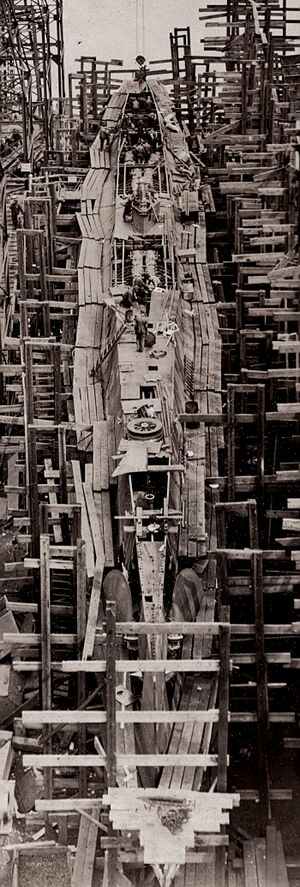
At the bow the covers have not been installed over the bow planes rigging and rotating gears. The purpose of the large wheel-like object on the forward deck is unknown, but it possibly part of the bow planes rigging system.
Photo in the private collection of Ric Hedman
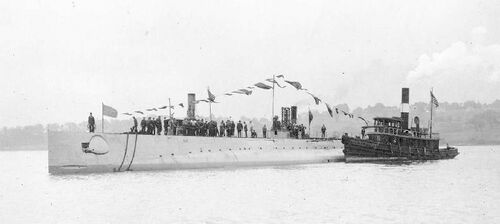
Photo provided by MMCM(SS) Rick Larson, USN (Ret.)

Photo provided by MMCM(SS) Rick Larson, USN (Ret.)
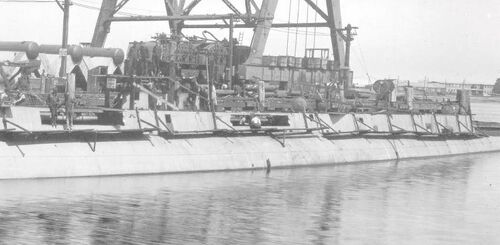
Photo provided by MMCM(SS) Rick Larson, USN (Ret.)
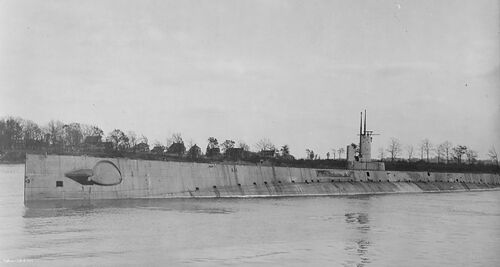
Photo in the private collection of Ric Hedman.

U.S. Navy photo
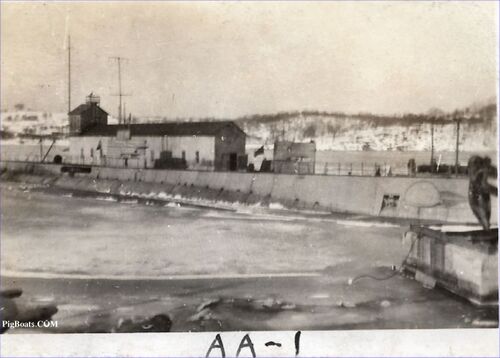
AA-1 shown alongside at Submarine Base New London, Groton, CT., February 1920. It was a very cold day, with portions of the Thames River frozen over with snow on the hills behind. The aft deck torpedo tube doors are open, with the tubes partially swung out to starboard. At this point she still retained the set of deck tubes forward of the fairwater, but they are not visible in this lower resolution photo because the doors are shut. Seven months after this photo was taken she would be renamed T-1.
Photo in the private collection of Ric Hedman.

The AA-1 appears to have mattresses and bedding being aired in the lifelines. The photo looks to have been taken from a barge moored to the dock. The photo taker was Seaman George Peterson, a cook striker, from the USS O-15 (SS-76).
Photo from the private collection of George Peterson, used with permission.
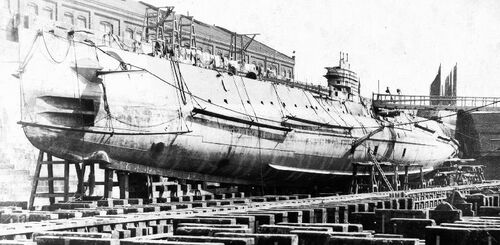
Photo provided by MMCM(SS) Rick Larson, USN (Ret.)
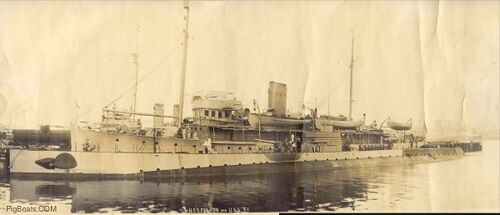
Photo provided by MMCM(SS) Rick Larson, USN (Ret.)
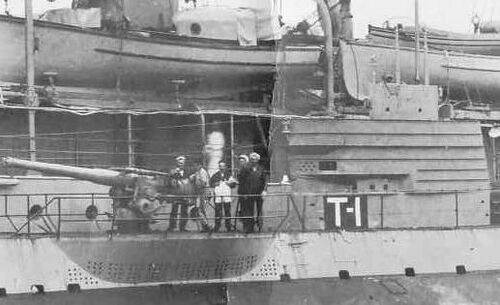
Photo provided by MMCM(SS) Rick Larson, USN (Ret.)

Photo in the private collection of Ric Hedman
Page created by:
Ric Hedman & David Johnston
1999 - 2023 - PigBoats.COM©
Mountlake Terrace, WA, Norfolk, VA
webmaster at pigboats dot com
